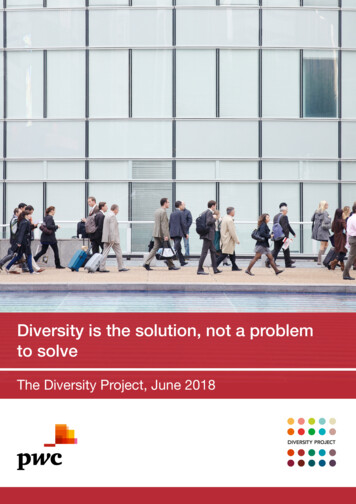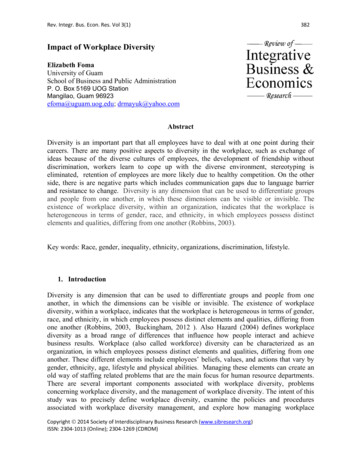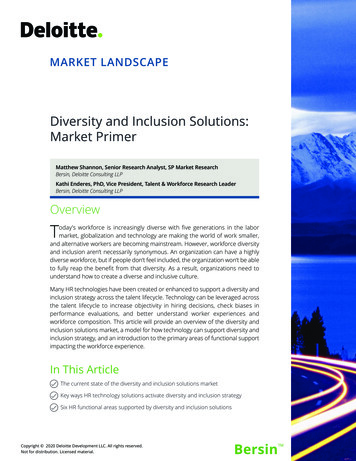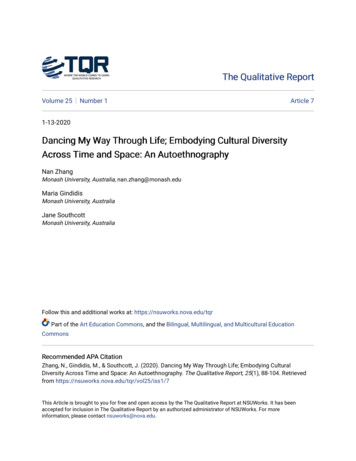
Transcription
Diversity is the solution, not a problemto solveThe Diversity Project, June 2018
Contents1Key benefits21. D iverse businesses create betteroutcomes for customers32. D iverse businesses createbetter business returns43. D iverse teams are more innovativeand create more value64. D iverse firms are more attractive topotential and existing employees75. F irms who have diversity and inclusion as a businesspriority improve their reputation and brand8Sources
Key benefitsFostering inclusive and more diverse workplaces can play an important role in addressingsome of the most important business issues, including creating better outcomes forcustomers; increasing innovation; helping to attract and retain talent; enhancing reputation andbrand; and ultimately generating higher returns.This paper summarises a number of findings from variouspieces of research that go some way towards evidencingthe benefits that diversity can provide. It should be notedthat the research reviewed is not exhaustive and does not initself “prove” the business benefits of a diverse organisation.That being said, it does provide strong indicators of thebenefits to go alongside the undisputed moral and ethicalarguments for ensuring equal opportunities for all employees(regardless of their gender, ethnicity, sexual orientationor background) and creating inclusive workplaces. Thebusiness benefits identified through the review of theresearch are set out below.1. Diverse businesses create better outcomesfor customersWith the future growth of financial services beingpredicated on firms successfully serving increasinglydiverse markets and customers, analysis indicates thathaving a diverse workforce can enable organisations tobetter understand different segments of the population,anticipate their needs and deliver to them.2. D iverse businesses create better business returnsThere is various research and analysis that indicatesthat organisations with greater gender diversity in theirleadership teams are more likely to be more profitableand generate greater shareholder returns. Similaranalysis indicates greater returns for those organisationswith greater ethnic diversity in their leadership teams.3. Diverse teams are more innovative and createmore valueResearch shows that executives recognise that a diverseset of experiences, perspectives, and backgrounds arecrucial to innovation and the development of new ideas. Research indicates that diversity-leading organisationsare rated by their leaders as more agile than theirmore homogenous counterparts, and more likely toexperiment and embrace failure in pursuit of differentand innovative approaches.4. D iverse firms are more attractive to potential andexisting employeesHaving a diverse and inclusive workforce is crucialfor companies that want to attract and retain talent.Research shows that a diverse and inclusive workplaceis an important element of attracting and retaining talent,both male and female. Research indicates that organisations who embracetechnology, flexibility and new ways of working willfind themselves not only more attractive to potentialand existing employees, but can lead to an increasein productivity and morale.5. Firms who have diversity and inclusion as a businesspriority improve their reputation and brandA focus on diversity makes a positive impact uponcompany image and reputation, resulting in increasedattraction and retention of talent and improvedstakeholder relationships. Evidence shows that leaders believe that diverse teamsenhance the promotion of the employer brand.1
1. Diverse businesses create better outcomes for customers Without diverse leadership, a number of diverse groupsincluding LGBT women are less likely than straight white mento win endorsement for their ideas. This has a negative impacton market opportunities, due to diverse contributors betterunderstanding the needs in under-leveraged markets.1 A team with at least one member having common traits orsharing ethnicity with the end user, better understands thatuser than more homogeneous teams.1 A diverse workforce can enable organisations to betterunderstand different segments of the population, anticipatetheir needs and deliver to them.2 A diverse workforce improves a company’s ability to engage adiverse client base and succeed in a wider number of markets.3 With women, on average, being more responsible for householdspending decisions, it could follow that an organisation withgreater female leadership may enhance the understanding ofcustomer preferences.5 While not all women clients prefer a woman adviser, thescarcity of women advisers is a significant stumbling blockto those women – and men – who do.6 Numerous leaders from Government and the Financial Servicessector have demonstrated their belief that gender diversity isn’tjust the right thing to do but that a balanced workforce is goodfor business, customers, profitability, workplace culture, and isattractive for investors. Additionally they believe that firms witha good gender balance in senior positions and across teamsperform better, and attract the best talent.7 Cross-cultural understanding, along with local marketknowledge, lends itself to the production of more effectivemarketing strategies, including culturally sensitive translationsof websites, brochures, and other assets.41 [HBR] novation2 [Mercer] rvices-perspectives-Mercer.pdf,3 /252210,4 [Hult] ral-diversity-workplace/,5 [Credit Suisse] r/file/index.cfm?fileid 88EC32A9-83E8-EB92-9D5A40FF69E66808, Reference isnot specific to fund management but in relation to the issue in general6 [State Street] .pdf7 diversity-for-better-pensions-v2.pdf2
2. Diverse businesses create better business returns Organisations with greater gender diversity are 1.4 times morelikely to have sustained, profitable growth.1 Top-quartile companies with executive-level gender diversityhad a 21 percent and 27 percent likelihood of outperformingtheir fourth-quartile peers on EBIT margins and longterm value creation (as measured by an economic-profitmargin) respectively.2 For ethnic and cultural diversity, the finding was a 33 percentlikelihood of outperformance on EBIT margin.2 Teams with an equal gender mix perform better than maledominated teams in terms of sales and profits.3 There is evidence suggesting that success is often equatedwith diversity characteristics, such as sex and race/ethnicity.4 Fortune 500 companies with the highest representation ofwomen board members attained significantly higher financialperformance than those with the lowest representation, withnotably stronger than average performance at companies withthree or more women board directors.5 Relative share price outperformance of companies with womenon the board is not entirely consistent, but the evidencesuggests that more balance on the board brings less volatilityand more balance.6 Some research supports the idea that there is no causationbetween greater gender diversity and improved profitabilityand stock price performance, rather the positive link may beas a result of the positive signal that is sent to the market bythe appointment of more women.6 There is strong consensus within academic research that morewomen on the board improves performance on corporate andsocial governance metrics.6 Melissa Harper of Monsanto cited an inclusive culture asa leading catalyst of commercial success in the face of anincreasingly complex and global customer base.7 There has been a shift in investment management fromindividual portfolio managers to teams running funds andevidence suggests that teams do better than individualson average with teams of three deliver the best results.Cognitive diversity is the key to solving problems as it providesmore tools for solving problems. There is reason to believethere is a positive correlation between social category andcognitive diversity.8 An analysis of over 1,700 companies across 8 countries byBoston Consulting Group found companies with diversemanagement teams had higher gross profit margins thanless diverse companies.9 Female fund managers produce more consistent and lessvolatile performance than their male counterparts.10 Research by FTSE Russell suggests that diverse companiesand diverse boards of directors perform better.11Ethnicand culturaldiversity33%likelihood ofoutperformanceon EBIT margin21 [DDI] ,2 [Mckinsey] zation/our-insights/delivering-through-diversity3 [Harvard] ent4 [Shore et al.] 54d811d50363a052b794f1d2.pdf5 [Catalyst] rmance-according-latest6 [Credit Suisse] r/file/index.cfm?fileid 88EC32A9-83E8-EB92-9D5A40FF69E66808 Reference is notspecific to fund management but in relation to the issue in general7 [Russell Reynolds] 20GameChangers%20FINAL.PDF8 [Credit Suisse] guage ENG&format PDF&sourceid csplusresearchcp&documentid 1074677761&serialid 4nVFWyrExy%2BlOirO84AqroGIVWY2NAeugIptVGTw2Fc%3D Reference is not specific to fund management but in relationto the issue in general9 teams-a8174471.html?amp10 /en outnumbered female fund managers.pdf11 0passive%20investments.pdf3
3. Diverse teams are more innovative and create more value Leaders from more gender diverse companies were twiceas likely as their low-diversity counterparts to report thattheir leaders work together to create new solutions andopportunities. They were also 1.5 times more likely to workacross organisational boundaries and create synergies intheir efforts.1 A greater proportion of women was associated with highercollective intelligence – the general ability of a group toperform a wide variety of tasks.4 Diversity leading organisations were rated by their leadersas more agile than their more homogenous counterparts,and more likely to experiment and embrace failure inpursuit of different and innovative approaches.1 Researchers studied people working in teams of 2 to5 found that teams’ collective intelligence rose withthe number of women in the group, possibly becauseof the women’s higher performance on tasks requiringsocial sensitivity.5 Senior executives recognise that a diverse set ofexperiences, perspectives, and backgrounds is crucialto innovation and the development of new ideas. Amajority of respondents agreed that diversity is crucialto encouraging different perspectives and ideas thatfoster innovation.2 Research offers support for the argument that variationsin group demography can have both direct and indirecteffects on how teams work together and perform. Underideal conditions increased diversity can have positivebenefits to decision making.6 82 percent of respondents believe that diversity ledto the development of new products. One-quarter ofthese believe that diversity led to products for only newcustomers, and half for both new and existing customers.3 More than 92 percent respondents believe that diversityled to innovation in human resource management and staffrecruitment and development practices.34 Gender-balanced teams were the most likely toexperiment, be creative, share knowledge, and fulfil tasks.4 Employees who feel included in an organisation are morelikely to feel comfortable to make positive contributions.7 Evidence suggests that greater team diversity can lead tobetter performance. It is not necessarily the performanceof the minority individuals but the fact that the majoritygroup improves its own performance in response tominority involvement.8
On average, most individuals in a working group will havesomething to offer and provided each member of the group isgiven a chance to share their knowledge, the outcome for theteam is likely to be greater than the sum of the parts.8 Research titled ‘Unleashing the Power of Diversity’ found thatPeople in inclusive workplaces perform to higher levels in theirwork. They are more productive and effective and more likely toattract new business.11 There are nine key criteria that, on average, define any goodleader. Interestingly, women apply five of these nine leadershipbehaviours more frequently than men. Women were found tobe particular good at defining responsibilities clearly as well asbeing strong on mentoring and coaching employees. Men weremuch better at taking individual decisions and then correctiveaction should things go awry. Hence, the idea that a degree ofgender diversity at the board level would foster a better balancein leadership skills within the company may hold merit.8 The CFA Institute found evidence suggesting strong businessand values-driven support for greater diversity, in which genderdiversity is simply one particularly significant case of divers
Key benefits 1. Diverse businesses create better outcomes for customers 2. Diverse businesses create3 better business returns 3. Diverse teams are more innovative and create more value 4. Diverse firms are more attractive to potential and existing employees 5.











